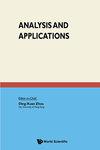A new elliptic mixed boundary value problem with (p,q)-Laplacian and Clarke subdifferential: Existence, comparison and convergence results
IF 2
2区 数学
Q1 MATHEMATICS
引用次数: 2
Abstract
The goal of this paper is to investigate a new class of elliptic mixed boundary value problems involving a nonlinear and nonhomogeneous partial differential operator [Formula: see text]-Laplacian, and a multivalued term represented by Clarke’s generalized gradient. First, we apply a surjectivity result for multivalued pseudomonotone operators to examine the existence of weak solutions under mild hypotheses. Then, a comparison theorem is delivered, and a convergence result, which reveals the asymptotic behavior of solution when the parameter (heat transfer coefficient) tends to infinity, is obtained. Finally, we establish a continuous dependence result of solution to the boundary value problem on the data.一个新的具有(p,q)-Laplacian和Clarke次微分的椭圆混合边值问题:存在性、比较和收敛性结果
本文的目标是研究一类新的椭圆混合边值问题,该问题涉及一个非线性非齐次偏微分算子[公式:见正文]-拉普拉斯算子和一个由Clarke广义梯度表示的多值项。首先,我们应用多值伪单调算子的满射性结果来检验温和假设下弱解的存在性。然后,给出了一个比较定理,得到了一个收敛结果,该结果揭示了当参数(传热系数)趋于无穷大时解的渐近行为。最后,我们建立了边值问题解对数据的连续依赖性结果。
本文章由计算机程序翻译,如有差异,请以英文原文为准。
求助全文
约1分钟内获得全文
求助全文
来源期刊
CiteScore
3.90
自引率
4.50%
发文量
29
审稿时长
>12 weeks
期刊介绍:
Analysis and Applications publishes high quality mathematical papers that treat those parts of analysis which have direct or potential applications to the physical and biological sciences and engineering. Some of the topics from analysis include approximation theory, asymptotic analysis, calculus of variations, integral equations, integral transforms, ordinary and partial differential equations, delay differential equations, and perturbation methods. The primary aim of the journal is to encourage the development of new techniques and results in applied analysis.

 求助内容:
求助内容: 应助结果提醒方式:
应助结果提醒方式:


